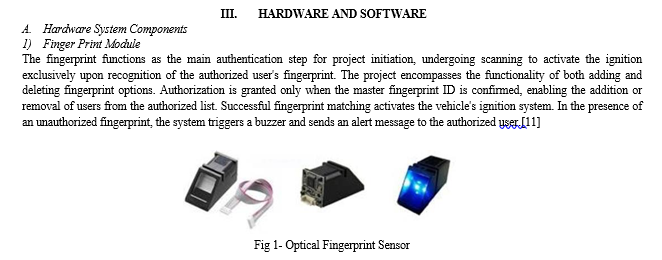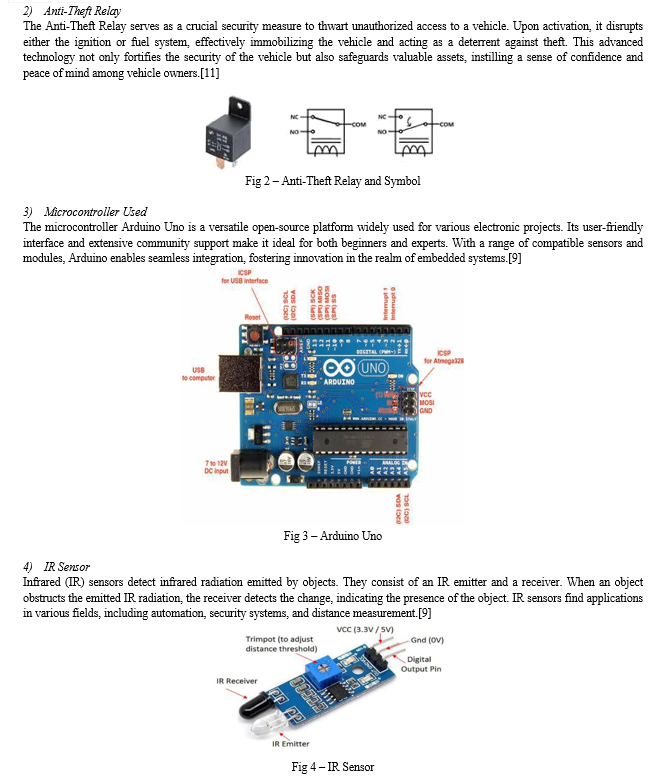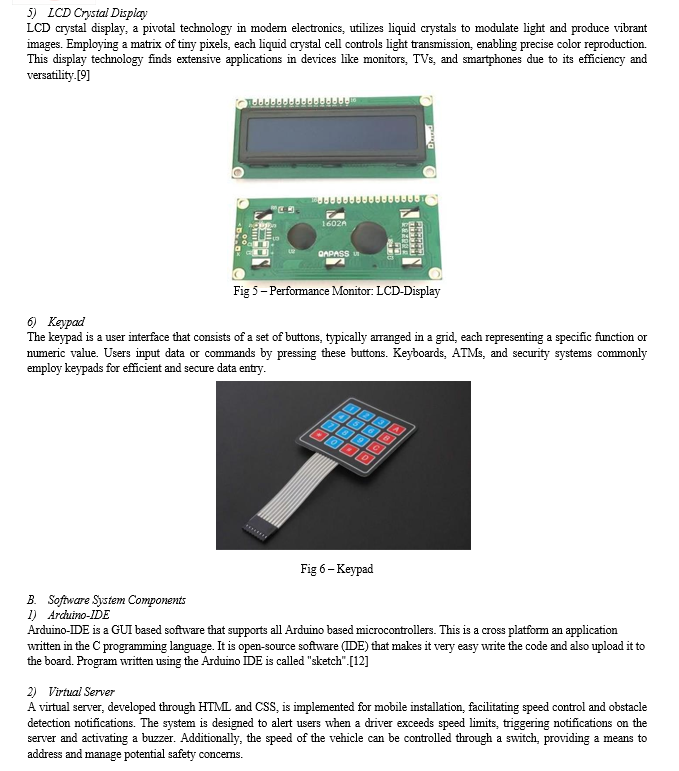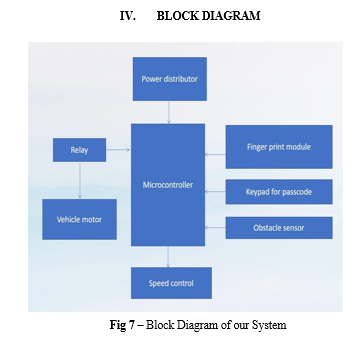Ijraset Journal For Research in Applied Science and Engineering Technology
- Home / Ijraset
- On This Page
- Abstract
- Introduction
- Conclusion
- References
- Copyright
Vehicle Anti-Theft System Using Fingerprint & Passcode with Speed Control and Obstacle Detection
Authors: Shivesh Mehta, Swadha Srivastava, Tapesh Pratap Singh, Geetanjali Raj
DOI Link: https://doi.org/10.22214/ijraset.2024.61914
Certificate: View Certificate
Abstract
This review paper explores the integration of a comprehensive vehicle anti-theft system, combining fingerprint and passcode authentication with speed control and obstacle detection. The rising concern of vehicle hijacking and theft emphasizes the need for enhanced security measures within the automotive industry. Leveraging biometric systems, known for their effectiveness in diverse applications, proves to be a promising solution. Biometric systems utilize unique biological traits to identify individuals, employing algorithms to ensure accurate user identification. In this suggested system, the signals produced by the Arduino Uno are directed to the relevant circuit within the module. Simultaneously, paper delves into the crucial relationship between security and performance monitoring in vehicles, emphasizing the significance of the speedometer as a vital component. Furthermore, the study advocates for the development of a cost-effective obstacle avoidance system applicable to both robots and automobiles, aiming to prevent accidents and minimize damage. This comprehensive approach combines advanced security, performance monitoring, and obstacle detection, offering a multifaceted solution to mitigate the risks associated with vehicle theft and enhance overall safety in the automotive realm.
Introduction
I. INTRODUCTION
Fingerprint recognition technology offers a secure and convenient solution for access control. Unlike traditional methods such as keys or passwords, this technology relies on stored fingerprints for authentication. Even when confronted with power outages or battery depletion, the stored fingerprints remain unaffected. The system guarantees that only authorized users can unlock it, as there are no keys or passwords susceptible to replication or theft. This innovative approach eliminates the need for managing keys or memorizing complex combinations. In summary, the use of fingerprints to unlock locks presents a reliable
and user-friendly alternative to conventional access control methods [1]. To enhance security and prevent unauthorized access to devices, modern authentication methods such as passwords and patterns are commonly employed. Nevertheless, password-based systems are susceptible to weaknesses like password leakage, making them vulnerable to theft and replication. This paper introduces an innovative approach to authentication, integrating an additional layer of security to enhance the traditional password pattern [2]. Over time, biometric systems have proven to be reliable security measures across different fields. Among the various forms of biometric identification, fingerprints stand out as the oldest and most extensively employed. To harness the benefits of this technology, it is essential to integrate fingerprint recognition into pre-existing systems, such as those employed in vehicles [3].
The rising incidence of vehicle theft worldwide has spurred significant interest in enhancing vehicle security systems. While most advanced security systems cater to four-wheelers, two-wheelers face a gap in effective protection against well-equipped thieves. Current market offerings for two-wheeler security systems fall short in comparison. In response, the proposed two-wheeler vehicle safety system (TWVSS) boasts a responsible and strong design that aims to enhance vehicle security and prioritize rider safety [4]. The two types of fingerprint matching techniques are graph based and minutiae based. The size of the biometric information template, which is derived from minutiae, is notably smaller, resulting in quicker processing speeds when compared to graph-based fingerprint matching [5].
II. LITERATURE REVIEW
This paper by Ajinkya Kawale delves into an innovative fingerprint-based locking system, emphasizing the use of fingerprint recognition technology for enhanced security and access control. The system, driven by a PIC16F876A microcontroller, eliminates the need for traditional keys or passwords, relying solely on pre-stored fingerprints for access.
It incorporates additional features such as an alarm system for unauthorized attempts, GPS-GSM notifications, and fuel injector deactivation to prevent unauthorized vehicle start-up. The study underscores the reliability of fingerprint recognition as a biometric security measure, detailing the minutiae-based approach and outlining the system's development plan. Envisioning a 'Keyless World,' the paper explores the broader applications of fingerprint-based locks in contemporary security systems.[1]
The research explores a Fingerprint Based Ignition System for vehicles, emphasizing the superiority of fingerprint biometrics over traditional key-based security. The prototype includes a fingerprint analysis software module, hardware interface, and ignition system module. Authorized ignition is ensured by comparing fingerprints with a database, and the system is connected to the vehicle's ignition through a dedicated circuit. The study highlights the reliability of fingerprints as a unique identifier. The developed prototype lays the groundwork for future research on robust real-time fingerprint-based vehicle ignition systems, concluding that fingerprint-based biometrics enhance vehicle security by preventing unauthorized access and ignition.[6]
The research paper, Finger print & Passcode based anti-theft vehicle system proposes an integrated and cost-effective security solution for vehicles. The system combines a Fingerprint Detection Subsystem (FDS) using an optimized PCA algorithm, GPS, GSM, and an Arduino Uno microcontroller. The FDS ensures fingerprint recognition, while GPS and GSM provide real-time location tracking and communication. The system enables remote vehicle control via mobile messages, including a panic button for emergencies. Emphasizing the need for advanced security beyond traditional alarms, the paper advocates for the integration of biometric recognition, image processing, and communication technologies to create efficient and reliable anti-theft solutions.[8]
This research paper highlights the significance of addressing the issue of vehicle over-speeding as a major cause of accidents. The paper emphasizes the need for technology-based speed limit enforcement systems and introduces a system utilizing Arduino, IR sensors, and an LCD display to detect and alert over-speeding vehicles. The related work section reviews various approaches, such as Radio Frequency-based speed control, rash driving detection devices, camera-based speed measurement, and intelligent transportation systems. Each approach aims to enhance traffic monitoring and control, demonstrating a shift towards automated systems over manual interventions. The proposed system in this paper contributes to this trend by offering a cost-effective solution for detecting and reporting over-speeding vehicles through automation, which is vital for efficient traffic management and road safety.[9]
The research paper addresses the global rise in vehicle thefts by proposing an integrated security and monitoring solution.
This paper introduces a novel approach using a password-protected initiation system, detailing the fabrication of a low-cost hardware module with an LCD, a 4x4 matrix membrane keypad, and a relay switch controlled by an Arduino processor. This module serves as an additional keylock for the engine, enhancing security. Emphasizing the need for an encrypted starting system. The integrated prototype aims to provide a comprehensive solution to vehicle security issues, with the conclusion suggesting potential enhancements for future development, including Wi-Fi data relay and a mobile application for real-time tracking and system override. The literature review references relevant works on biometrics-based security systems, RFID technology, GPS-based tracking, and cost-effective speedometers, positioning the research within the broader context of existing solutions.[10]




V. RESULTS AND DISCUSSION
To ensure the accuracy of a project or system, it must undergo testing across various conditions. Evaluating scenarios for this project involves both sanctioned and unsanctioned endeavors to enter the system, necessitating fingerprints and entry codes from individuals in both groups. The Arduino board is linked to the microcontroller, and when a finger is placed on the fingerprint sensor, it scans and compares the data with pre-loaded information. If the fingerprint and passcode match, and input is provided to the Arduino controller, the ignition system can be activated. Conversely, if the fingerprint and passcode do not match, the ignition system remains inactive, preventing current flow and keeping the engine in the off state.
Engine control is achieved with a single finger, where the initial touch ignites the engine, and a subsequent touch with the same finger turns it off. The display indicates the engine status as turned on or off by the authenticated person. Speed control is managed by a switch that, when pressed, increases the speed and triggers a notification on the server for speed control. The server's switch can be pressed to control the speed. Additionally, an IR sensor detects obstacles, sending a notification to the server and activating a buzzer.
Conclusion
In conclusion, this project has successfully developed a robust prototype for a fingerprint-based vehicle anti-theft system integrated with passcode protection, speed control, and obstacle detection. The intelligent agents within the system effectively communicate, delivering appropriate outputs based on user input. The system seamlessly processes user fingerprints, allowing only authorized users to start the vehicle, thereby enhancing automobile security. Notably, the system accommodates new users by enrolling their fingerprints upon request, but a passcode authentication step adds an extra layer of security. Users can also modify their passcodes through the system interface, providing flexibility and customization. The implementation of fingerprint technology in vehicles not only improves security but also ensures that the car is accessible only to authorized individuals. This innovative system contributes to the enhancement of car security in a cost-effective and readily available manner. The system\'s output, conveniently displayed through an LED interface, exemplifies the successful integration of biometric recognition technology. Compared to traditional methods of personal recognition, biometric systems offer a superior combination of security and convenience, marking a significant advancement in the realm of vehicle security. This prototype serves as a testament to the potential for future advancements in vehicle anti-theft systems, providing a reliable and user-friendly solution to address the challenges associated with unauthorized access and theft. Future avenues for exploration include the extension of this system to diverse types of vehicles beyond cars. Additionally, the integration of various other biometric methods presents a potential avenue for further enhancement and customization.
References
[1] Ajinkya Kawale, “Fingerprint based locking system”, International Journal of Scientific & Engineering Research, Volume 4, No 5, pp.899 -900, May-2013. [2] Arpit Agrawal and Ashish Patidar, “Smart Authentication for Smart Phones”, International Journal of Computer Science and Information Technologies, Vol. 5, No4, pp.4839-4843,2014. [3] Omidiora E. O. Fakolujo O. A. Arulogun O. T. and Aborisade D. O, “A Prototype of a Fingerprint Based Ignition Systems in Vehicles”, European Journal of Scientific Research, Vol.62, No.2, pp. 164-171, 2011. [4] Prashant Kumar R., Sagar V. C., Santosh S.2, Siddharth Nambiar, “Two-Wheeler Vehicle Security System”, International Journal of Engineering Sciences & Emerging Technologies, Volume 6, No. 3, pp. 324-334, 2013. [5] Karthikeyan. A & Sowndharya. J, “Fingerprint Based Ignition System”, International Journal of Computational Engineering Research, Vol. 2, Issue No.2, pp. 236-243. 2012. [6] Mudholkar, S. S., Shende, P. M. & Sarode, M. V. “Biometrics Authentication Technique for Intrusion Detection Systems Using Fingerprint Recognition”, International Journal of Computer Science, Engineering and Information Technology (IJCSEIT), Vol.2, No.1, 2012. [7] CH. Hema Nandini, CH. Sravani, “FINGER PRINT BASED VEHICLE STARTING SYSTEM”, Journal of Emerging Technologies and Innovative Research, JETIR May 2023, Volume 10, Issue 5, ISSN-2349-5162. [8] Mr. Prashanth. S, Mr. Sachin Kumar. BU, “FINGER PRINT & PASCODE BASED ANTI-THEFT VEHICLE SYSTEM”, International Research Journal of Modernization in Engineering Technology and Science, Volume: 04/Issue:07/July-2022, ISSN: 2582-5208. [9] Manipriya Vutturi, Susmitha Palle, “Automatic Speed Detection and Reporting System Using Arduino”, International Journal of Scientific Engineering and Research (IJSER) ISSN (Online), Volume 8 Issue 1, January 2020. [10] Safayet Khan, Obaidur Rahman, “Design and Fabrication of a Password Protected Vehicle Security and Performance Monitoring System”, 2017 IEEE Region 10 Humanitarian Technology Conference (R10-HTC). [11] Akinwole Bukola, “Development of an Anti-Theft Vehicle Security System using GPS and GSM Technology with Biometric Authentication”, International Journal of Innovative Science and Research Technology ISSN No:2456-2165, Volume 5, Issue 2, February – 2020. [12] Joel Sachin, Kiran Rana Gill, “Anti-Theft System for Vehicles Using Fingerprint Sensor”, International Journal of Scientific & Engineering Research, Volume 7, Issue 7, July-2016 1436, ISSN 2229-5518.
Copyright
Copyright © 2024 Shivesh Mehta, Swadha Srivastava, Tapesh Pratap Singh, Geetanjali Raj. This is an open access article distributed under the Creative Commons Attribution License, which permits unrestricted use, distribution, and reproduction in any medium, provided the original work is properly cited.

Download Paper
Paper Id : IJRASET61914
Publish Date : 2024-05-10
ISSN : 2321-9653
Publisher Name : IJRASET
DOI Link : Click Here
 Submit Paper Online
Submit Paper Online

